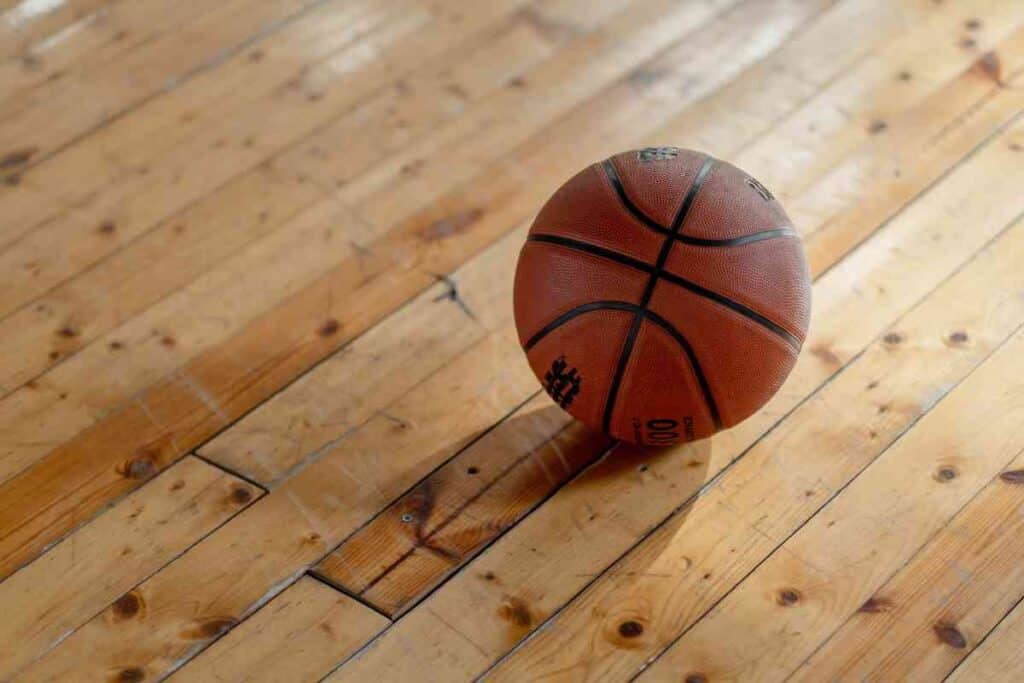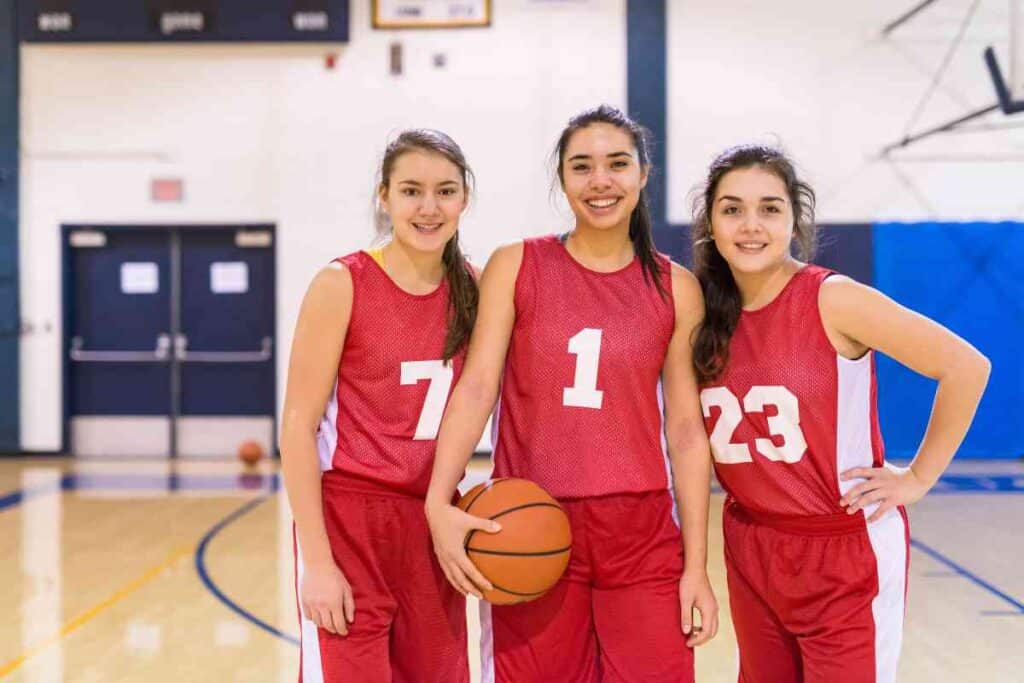High School Basketball Size & Weight Rules Explained
Ever wondered how basketballs came to be? Who decided what a basketball would be? What are the proper dimensions for high school basketball size and weight?

What are the correct dimensions for a high school basketball?
Stipulated by the rules of the NFHS that governs high school athletics, a Size 7 B-ball must be used for all boys’ basketball games. The basketball has a circumference of 29.5 inches and a weight of 22 oz. High school girls’ hoops are required to use a Size 6 basketball (28.5 inches and 20 oz).
Anyone who is a student of the game knows that basketball has changed a lot from the game Dr. James Naismith invented in 1891. Tasked with developing a game that students could play indoors, his answer was to fasten a couple of peach baskets on opposite ends of the court, divide the youth into two teams, and hand them a leather soccer ball laced with stitches.
(The first ball didn’t bounce. It would be ten years before dribbling was introduced).
While there have been many variations, basketball’s evolution has made the game faster, higher scoring, and a whole lot more fun to watch. But who is responsible for decreeing the size and weight of modern basketball? Why are there different basketball sizes for young players, men and women? Well, let’s examine the question of basketball sizes in more detail.
What Size and Weight Do High School Basketballs Have To Be?
According to the rulebook, there are specific regulations for determining the ball size used for playing both boys’ and girls’ basketball programs.

Boys’ Official Size, Shape, and Weight
The standard basketball size for boys’ athletics is a Size 7 basketball, meaning that it must be spherical, have 29.5 inches in circumference, and be approved for play with an NFHS authentication mark.
The ball can not be less than 20 ounces or a maximum weight of 22 ounces. This circumference is used in all youth basketball (age 15 and up), men’s NCAA, NBA, and FIBA teams (international). The NBA adopted the Size 7 basketball in 1984 after having experimented with a smaller version for a couple of years.
Girls; Official Size, Shape, and Weight
The correct size ball used for girls’ basketball programs must be a Size 6 basketball, which is spherical, 28.5 inches in circumference, be approved for play by NFHS authentication, and not weigh less than 18 ounces with a maximum weight of 20 oz.
Why Is There A Different Size Basketball of Balls for Boys and Girls?
The answer to why there are different basketball sizes goes back to the beginning days of the WBL (Women’s Basketball League) in 1978.
When the league formed, it was suggested that the ladies should play with a smaller ball than the men. The reasoning was that a woman’s hands were smaller, so a basketball with less circumference made it simpler to grip. In addition, most manufacturers felt that a woman’s upper body strength was less than a man’s (which is not always true), and this assumed fact justified the use of a lighter ball.
The league adopted the smaller Size 6 basketball and used it for the three years it existed. When the WNBA was formed, they adopted a smaller size.
The NCAA adopted the Size 6 basketball for women’s basketball in 1984. NFHS followed suit by designating two official sizes of basketballs to use, one for the boys’ programs and the other for the girls.
As a general rule, the lighter ball is considered easier to handle than a standard ball that boy basketball players use. In addition, the downsized dimensions allowed for better grip, quicker passing, and increased shooting range. The result of the new size was that women’s basketball games became intensely popular among fans because they were often played at a faster pace.

Who Decides What High School Basketballs Should Be?
For the competition to be fair and equitable, basketball leagues across the country follow the same basic rulebook. The NFHS (National Federation of State High School Associations) is the organization that oversees the regulations for 16 different sports played by youth sports (elementary, middle school, and high school).
With over 18,500 high schools alone as members, it is easy to see how extensive the reach of their rulebook is. Every state plus the District of Columbia are members, which ensures that no matter where a team plays, the contest will be governed by the same rules.
While much more complicated than Dr. James Naismith’s original 13 rules, the NFHS rulebook has ten basic rules and hundreds of articles, subsections, and paragraphs. ‘The guidelines attempt to cover every contingency, from uniforms to times to fouls and points to even how far the basketball coaches’ box can extend from the bench.
All high school basketball leagues must be played with an approved NFHS basketball (stamped with an NFHS-authenticated marking at the factory). The manufacturer enters into an agreement with the maker to make the basketballs to their exact specifications.
The distinguishing mark ensures that all high school basketball leagues use the same equipment. The mark also helps the basketball referee identify the ball as legally approved when the home team presents the game balls to the official
According to rule 1, section 12, article 3, the referee is the sole judge of whether the basketball is acceptable for play, and the mark makes his job much more manageable.
Do High Schools Have to Use the Same Manufacturer?
The NFHS rules do not stipulate who has to manufacture the ball used in basketball games. While Spalding was the sole producer for several years, most youth leagues, NFHS (boys), NCAA (men’s), and men’s professional basketball associations use balls made by Wilson.
It is generally thought that Wilson makes a basketball that is just as good but costs less than the Spalding brand, which saves cash-strapped school districts significant amounts of money they can funnel toward other programs.
What Basketballs Should We Use For Practice?

One of the ideas of practicing is to simulate game-day situations as much as possible. The manufacturer doesn’t matter as long as all the balls are the same size.
The high school basketball coach (or equipment manager) should inspect the basketballs daily before each practice to ensure they are all the same size and are still viable (all b-balls show age as they are used). There should be no defects on the surface, and the basketballs should conform to regulations for size and weight. Any under-inflated basketballs should be aired up to the correct weight and have sealant inserted to ensure continued use.
It is common for more extensive programs that have both boys’ and girls’ programs for the downsized basketballs to get mixed, so an inspection is needed to ensure that players do not use the wrong size ball.
Is There a Difference Between Outdoor Basketballs And Indoor Ones?
Indoor basketballs are made from synthetic leather, while outdoor ones have been constructed of rubber polymers.
The leather surface of the indoor basketball allows for a better feel and grip, and response on the playing floor. Outdoor basketballs are made from rubber, focusing on durability rather than feel.
Since no competitive basketball games (NFHS, college, or pro basketball) are played outdoors, there is no need to use an indoor ball when shooting hoops on the driveway. Outdoor balls are used for recreational purposes primarily.
How Many Basketballs are Used in a Typical Game?
The rules stipulate that the home team’s equipment manager or coach should provide four disinfected basketballs to the head referee for inspection. The basketballs must be wiped down and disinfected at the start of every quarter and the beginning of overtime.
Key Takeaways
- The official size of basketballs (boys, youth, college, and pro) use a Size 7 ball.
- The official ball size of a women’s basketball (girls ages 15 and up use is a Size 6.
- The home team is required to provide four game balls before each game.
